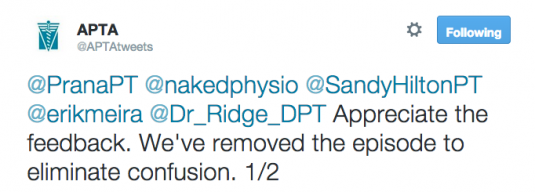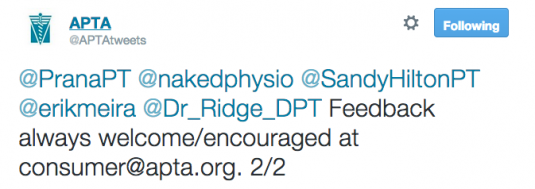
A Hand Raised in Concern
At the 2014 APTA Combined Sections Meeting in Las Vegas, during the Orthopaedic Section membership meeting, Dr. Catherine Patla stood up and expressed a notion to the Section’s Board of Directors. She was concerned physical therapists were giving away their hands (she also expressed a similar concern to the AAOMPT Executive at AAOMPT 2014). After over a year of consideration and contemplation, I have to agree. We are in the midst of a silent crisis of physical therapy scope of practice!
Motivated by Dr. Patla’s observations and concerns, I began keeping unofficial (and admittedly unscientific score) of students in my musculoskeletal programs and how their clinicals handled, well, the hand. Conservatively, about 50% of the students reports that they were expressly forbidden by clinic policy to treat hands, elbows, and to a lesser degree, shoulders. Concernedly, the distal upper extremity appears to be the land of the OT.
This is a complicated situation.
A Handsomely Negative Impact
From a profession-wide perspective, there’s not much that can easily be done to counteract clinic-level policies. Certainly, both Occupational Therapy and Physical Therapy are qualified to perform rehabilitation to distal upper extremity injuries. Furthermore, I think the ultimate care pathway, for many injuries common to the area, involves both professions. I’ve not actually met a member of either profession who thinks differently (or at least admitted as such), yet the policies exist.
This trend has potential long-term, and wide implications. From my perspective as Director of the Kaiser Hayward Physical Therapy Fellowship in Advanced Manual Therapy, this increases the challenge to train fellows, who by decree, must have experience treating and managing patients with distal upper extremity diagnoses. Outside of residency/fellowship training, new professionals may exist without ever getting to see a hand patient in some clinics/regions! Over time, the collective knowledge of physical therapists will be diluted and will atrophy. Soon no one will be left to TEACH the hand. At my previous University, it was common practice for the senior orthopaedic PT faculty to contract an OT to come in and teach the hand to DPT students. This was a constant and disappointing source of stress for me. What message does this send! We could literally be voluntarily cleaving off an important scope of our practice! The irony is, it’s the body region most important to how we treat! It’s decidedly more difficult to be a PT if you don’t have hands.
The Hand Rehabilitation Section
I don’t know any more than a couple people in the Hand Rehab Section of the APTA. Perhaps that’s my issue. Perhaps it’s because the Section itself is a bit of an anomaly. Of the 18 Sections within the APTA, it’s the only one designated by an anatomical focus. The other sections are delineated by practice areas like Orthopaedic or Neurologic, settings like Home Health, Acute Care, or Aquatics, or related professional activities like Research, Education, and Federal Advocacy. Arguably, the Women’s Health section is anatomically focused, but in fact it’s not, since Women’s Health is more broad than a pelvic floor and I think “The Vagina Section” would offer some terribly difficult search engine optimization challenges! I do not know the history of how the Hand was excised from the rest of the Orthopaedic Section and would love to learn.
All that criticism on name/organization aspects aside, you have to also argue that the Hand Section is doing the best it can with the membership audience it has (~472 members and 36 Facebook likes). It offered an outstanding selection of programming at this years CSM Meeting in Indianapolis. Everything from a high-profile lecture including ESPN’s Stephania Bell, to a comprehensive clinical reasoning model for TFCC management by Brenda Boucher and Pieter Kroon was offered. Notably, the Hand Rehab Section also offered two pre-conference courses and presented the results for projects for 3 different clinical practice guidelines: carpal tunnel, distal radius fractures, and lateral epicondyalgia. Yet, while all this is taking place, other PT’s seem more than happy to give up the hand and let someone else manage it. Let some other PROFESSION manage it.
Hands are for Holding
To me, this boils down to a grassroots effort, and is an issue of personal responsibility as a professional. You cannot in good conscious, let your clinic enforce and carry out a policy that prohibits, or through practice, eliminates the opportunity to treat any body region, especially the hand. We all know the outcry when outside professions claim a technique is only their purview, and attempts are made to remove that from our practice. Physical therapists rise up in a collaborative rage and claim it back. Yet, I see malaise and laziness, and an acceptance of insufficient knowledge as a behavior pattern among physical therapists in these clinics. That may seem harsh, but I can’t see it any other way.
My one caveat, and an important one at that, is that some hand injuries do require a very experienced hand specialist. Hand tendon surgical repairs quickly surpass entry-level practice. There is an insufficient numbers of physical therapists trained Certified Hand Therapists. In fact, I have only encountered one PT who holds the dual acclaim of Fellow of the Academy of Orthopaedic Manual Physical Therapists AND is a Certified Hand Therapist: the aforementioned, Dr. Boucher, who hails from Texas State University and teaches as part of the Manual Therapy Institute’s manual therapy fellowship program.
There are pathways, and opportunities that can happen, and I’ll outline my suggestions in just a moment, but this boils down to each and every physical therapy professional deciding to hold onto hands. It’s up to YOU!
Getting a Grip on this Problem
By all means, this is just a suggestion, but we need to start somewhere and why not now? Please comment, edit, innovate, or ACT on this:
- Hand Rehab education should be led by physical therapists as often as possible in DPT programs.
- Individual PT’s in clinics with hand-prohibitive policies should challenge these, and reach out to professional advocates like those in the Hand Rehab Section for assistance if needed.
- Consideration of upper extremity policies in DPT Clinical Education should occur.
- Joint clinical practice guidelines should be developed by OT’s and PT’s collaborating as authors.
- Increased visibility and ultimately membership in the Hand Rehab Section. 36 Facebook likes is not going to cut it. 472 members is difficult to defend.
- Development of post-professional pathways for Hand/Wrist/Elbow instruction including residencies, fellowships, and some stake in the Certified Hand Therapist credential.
- Consideration of how the Hand Section can further collaborate with the Orthopaedic Section (absorbed by the Ortho Section?) and AAOMPT to further their collective mission.
- Wide APTA support for these endeavors, including resources for training training, pathways for expertise, research, and advocacy.
Thanks for listening. Thanks for thinking. Thanks in advance for taking the challenge to not let this problem get any worse!



